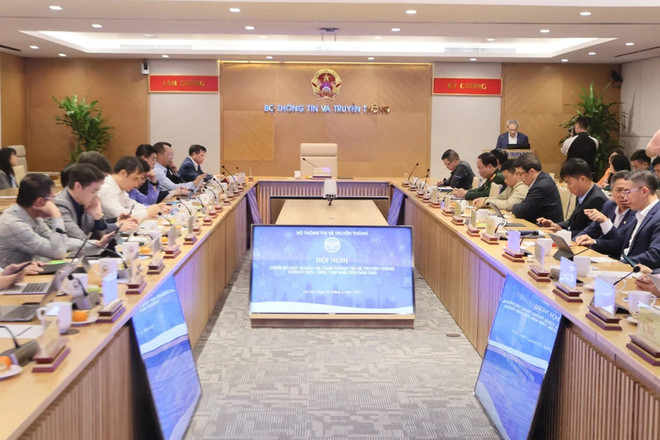 The conference announcing the information and communications infrastructure master planning scheme for the 2021 - 2030 period, with a vision to 2050. (Photo: Ministry of Information and Communications)
The conference announcing the information and communications infrastructure master planning scheme for the 2021 - 2030 period, with a vision to 2050. (Photo: Ministry of Information and Communications)Hanoi (VNA) – The Ministry of Information and Communications (MIC) held a conference on February 23 to announce the information and communications infrastructure masterplan with a vision to 2050.
The master planning scheme, approved by the Prime Minister on January 11, is of significant importance as it opens up a new space for socio-economic development, connects the development on the digital space with that in the traditional physical space, and creates an optimal environment for innovation to enhance the national competitiveness.
In this planning scheme, Vietnam sets high targets for information and communications infrastructure development to create infrastructure for building a digital government, digital economy, and digital society.
Digital infrastructure
The planning scheme aims for significant advancements in digital infrastructure by 2025. It envisions ubiquitous access to fiber optic cable for households, ensuring that 100% have access when needed.
Another target is that 100% of the adult population will own smartphones, and Vietnam will become one of the top 50 countries in the ICT Development Index (IDI) rankings of the International Telecommunication Union (ITU).
The planning scheme also outlines the establishment and deployment of at least three clusters of national multi-purpose data centres, and one or two regional data centres.
By 2030, the 5G broadband mobile network will cover 99% of the population, and the country will move to develop next-generation mobile networks. Four - six more international undersea cable routes will be developed. Up to 100% of state agencies and state-owned enterprises and over 50% of people will use cloud computing services supplied by domestic businesses.
Cyber information security
The planning project targets that by 2025, 100% of state agency information systems will have their safety guaranteed according to information system levels. All ministries, ministry-level agencies, and provincial-level People’s Committees will have their cyber security protected in four layers. And 100% of state agency terminal equipment will be installed with cybersecurity solutions.
By 2030, Vietnam will establish itself as one of the leading cybersecurity hubs in Asia. Its digital technology businesses will make use of open-source technologies to master technology and help with the safeguarding of cyber information security and digital government, digital economy, and digital society.
Information technology industry
By 2025, Vietnam will form and conduct plans and projects on 12 - 14 concentrated information technology (IT) zones and members of software park chains nationwide. It will shape clusters of concentrated IT zones in regions to ensure the connectivity of technology research and mastery with the production of digital technology products.
By 2030, 16 - 20 concentrated IT zones and members of software park chains will take shape. The country will strongly attract investment to and develop concentrated IT zones in Ho Chi Minh City, Hanoi, Da Nang, Hai Phong, and Can Tho cities. Concentrated IT zones in localities will be upgraded and expanded to become large regional bases housing research and development centres of big technology multinationals.
Key implementation solutions
The MIC also proposed several solutions for implementing the master planning scheme.
These include phasing out old-generation mobile telecommunications technology in favour of new technologies, and reallocating frequency bands to develop advanced 4G, 5G, and future generations of mobile networks.
The planning scheme recommends prioritising the development of the 5G mobile network starting from 2025, with the allocation of telecommunications resources based on the market mechanism to ensure the service quality meets global standards.
Key laboratories will be established to develop essential "Made in Vietnam" products tailored for digital government, digital economy, digital society, digital transformation, smart production, and smart agriculture.
The master planning scheme also includes targets for IT application infrastructure and the postal network./.
































